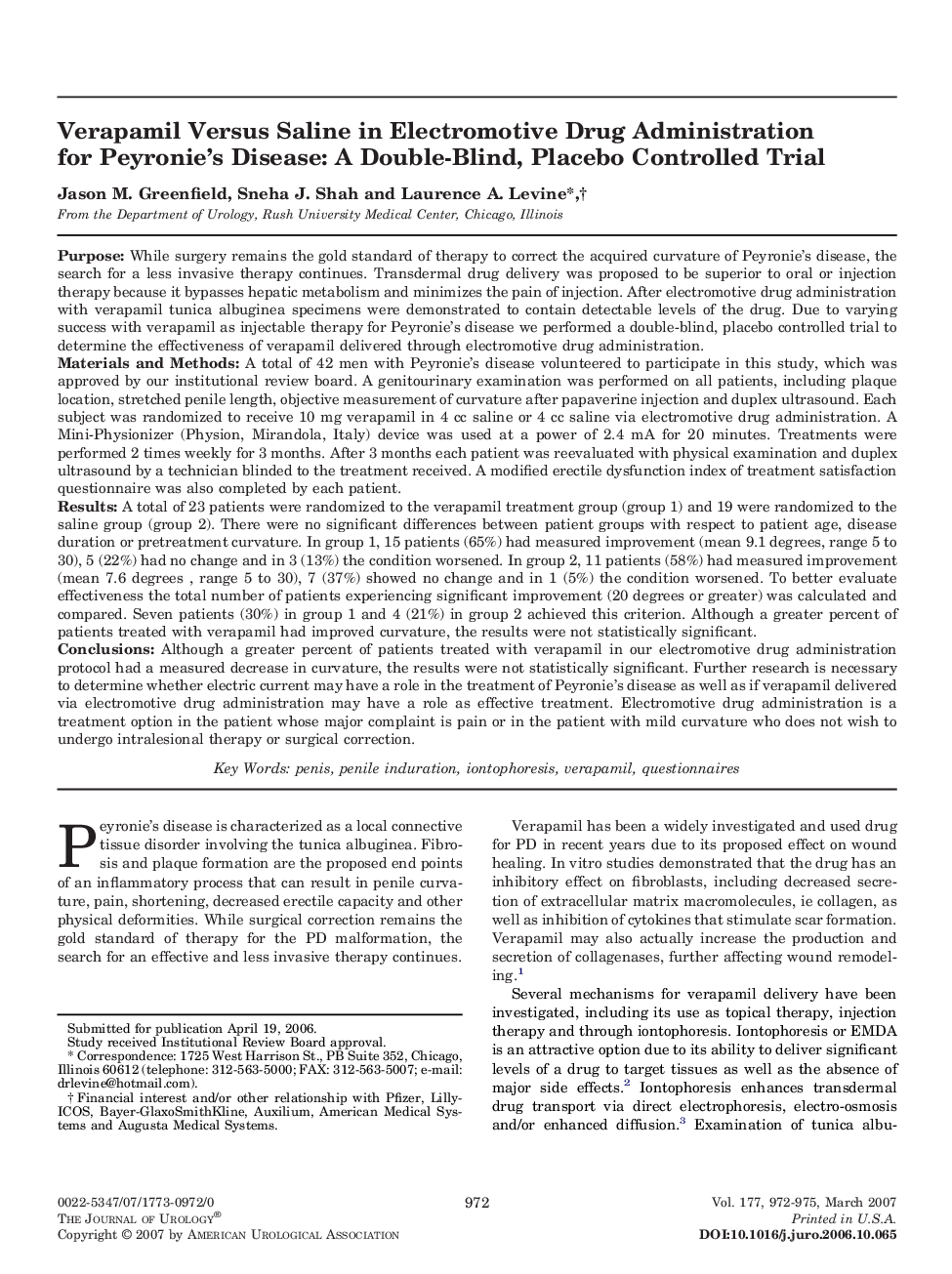| کد مقاله | کد نشریه | سال انتشار | مقاله انگلیسی | نسخه تمام متن |
|---|---|---|---|---|
| 3878974 | 1599012 | 2007 | 4 صفحه PDF | دانلود رایگان |

PurposeWhile surgery remains the gold standard of therapy to correct the acquired curvature of Peyronie’s disease, the search for a less invasive therapy continues. Transdermal drug delivery was proposed to be superior to oral or injection therapy because it bypasses hepatic metabolism and minimizes the pain of injection. After electromotive drug administration with verapamil tunica albuginea specimens were demonstrated to contain detectable levels of the drug. Due to varying success with verapamil as injectable therapy for Peyronie’s disease we performed a double-blind, placebo controlled trial to determine the effectiveness of verapamil delivered through electromotive drug administration.Materials and MethodsA total of 42 men with Peyronie’s disease volunteered to participate in this study, which was approved by our institutional review board. A genitourinary examination was performed on all patients, including plaque location, stretched penile length, objective measurement of curvature after papaverine injection and duplex ultrasound. Each subject was randomized to receive 10 mg verapamil in 4 cc saline or 4 cc saline via electromotive drug administration. A Mini-Physionizer (Physion, Mirandola, Italy) device was used at a power of 2.4 mA for 20 minutes. Treatments were performed 2 times weekly for 3 months. After 3 months each patient was reevaluated with physical examination and duplex ultrasound by a technician blinded to the treatment received. A modified erectile dysfunction index of treatment satisfaction questionnaire was also completed by each patient.ResultsA total of 23 patients were randomized to the verapamil treatment group (group 1) and 19 were randomized to the saline group (group 2). There were no significant differences between patient groups with respect to patient age, disease duration or pretreatment curvature. In group 1, 15 patients (65%) had measured improvement (mean 9.1 degrees, range 5 to 30), 5 (22%) had no change and in 3 (13%) the condition worsened. In group 2, 11 patients (58%) had measured improvement (mean 7.6 degrees, range 5 to 30), 7 (37%) showed no change and in 1 (5%) the condition worsened. To better evaluate effectiveness the total number of patients experiencing significant improvement (20 degrees or greater) was calculated and compared. Seven patients (30%) in group 1 and 4 (21%) in group 2 achieved this criterion. Although a greater percent of patients treated with verapamil had improved curvature, the results were not statistically significant.ConclusionsAlthough a greater percent of patients treated with verapamil in our electromotive drug administration protocol had a measured decrease in curvature, the results were not statistically significant. Further research is necessary to determine whether electric current may have a role in the treatment of Peyronie’s disease as well as if verapamil delivered via electromotive drug administration may have a role as effective treatment. Electromotive drug administration is a treatment option in the patient whose major complaint is pain or in the patient with mild curvature who does not wish to undergo intralesional therapy or surgical correction.
Journal: The Journal of Urology - Volume 177, Issue 3, March 2007, Pages 972–975